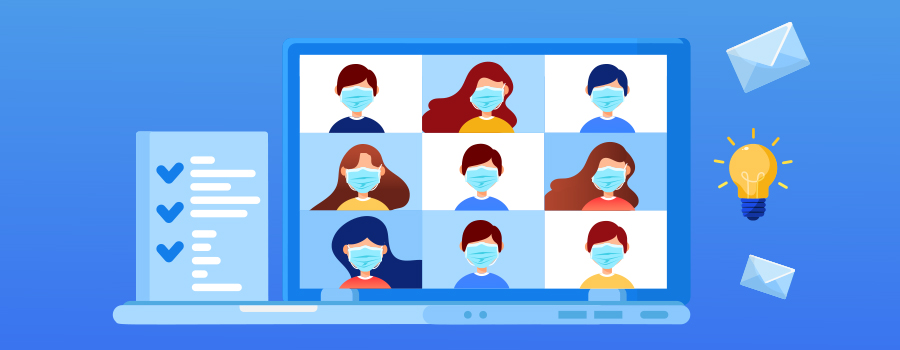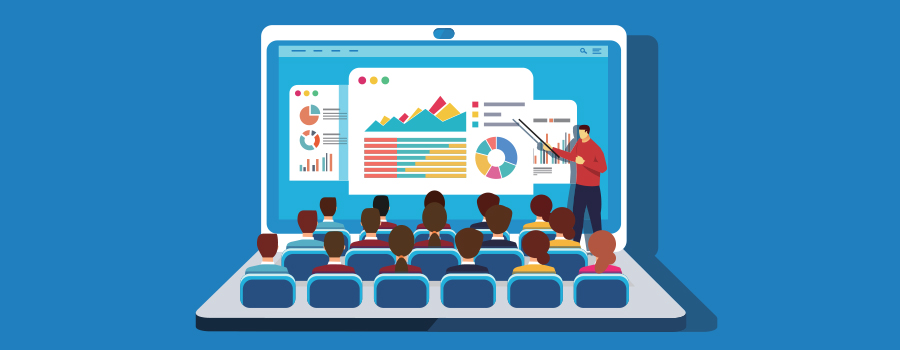Whether you’re looking to generate leads or grow your base of loyal customers, webinars can be an effective marketing and educational tool that continues to work for your company, long after the first broadcast.
You may be familiar with webinars already. In fact, 95% of businesses say webinars are a key part of their marketing strategy, according to a survey by On24. That’s because these online sessions have the ability to inform, educate and ultimately engage audiences—things that help us build customer interest and loyalty. But if your business is still new to webinars, it’s not too late to jump on the train.
What is a webinar?
A webinar is a seminar or learning session conducted via the internet. They can take a variety of forms, from single-person lectures to panels to interactive presentations. A webinar may be held live, or recorded and streamed to participants after the fact, usually in exchange for their contact or personal information.
While the pandemic spiked the adoption of webinars, it’s clear they’re here to stay as the world enters its new normal. That’s why it’s so important to do them right.
Whether you're looking to optimize or kickstart your webinar program, our checklist of best practices will help you produce memorable and successful webinars.
Your Awesome Webinar Checklist
Before the Webinar
✔Know your target audience: What problem do they need solved? What are their goals? The more value you can deliver to them, the more successful your webinar will be.
✔ Pick a relevant topic: Leverage Google Analytics to see what content is being viewed and shared the most on your website. Bring in your sales team to understand what customers are asking for, and watch what your competition is talking about (and put your own spin on it).
✔Choose engaging talent: Plan on organizing at least one or two experts, or even a panel. Have a sharp facilitator to keep the presentation flowing smoothly and coordinate questions, if applicable.
✔Develop a strong email strategy: Send regular reminder emails to your customers, and give them clear instructions for registering, logging on, asking questions of the presenters, etc.
✔Develop an effective promotional strategy: Write a blog post about the webinar to help promote it on social and email. Leverage your social media audience to help spread the word. If you have a niche business or B2B audience, consider promoting your webinar in relevant trade journals.
✔Create a webinar landing page: Use it drive registrations and share important information such as topic, speakers, and event logistics. Having a main spot for registrations and traffic will also help you track how users are responding to your promotional strategy. Keep the page simple and focused (as all landing pages should be).
✔Choose the best webinar platform for you: Make sure the platform you choose can support the number of attendees you need and has the capabilities you need, whether it's interactive tools for polling and Q&As or reporting capabilities to compile attendee data.
✔Use quality equipment: With so many options for webinars online today, you need to stand out from the competition. Make sure every presenter uses a good mic and headset; remember that attendees will tolerate bad video, but will flee presentations with bad audio.
✔Practice, then practice again: Test your equipment repeatedly to ensure you know how to use it and what to do if something goes wrong—at least two dry runs! Make sure that the room you present from is quiet, and that you have a stable, high-speed internet connection.
✔Develop visual slides: The fewer words, the better—data visualizations and different forms of media, like video and animation, will help keep attendees’ interest. Keep mobile in mind, as some viewers will likely join from their phones.
During the Webinar
✔Interact with attendees: Post surveys or polls, or consider stopping for periodic Q&As with your presenters. Get bonus points for having some strategic questions prepared ahead of time. Monitor the comment box, if enabled, for questions or technical difficulties
✔Educate, then sell: Establish yourself as a trusted expert. Think of the webinar as teaching your audience what they want. When it's time to offer your product or service, it will be what they're wanting

After the Webinar
✔Survey attendees: Ask your viewers what they thought, and how you can improve the next webinar. This will build their buy-in and loyalty as you continue producing digital content.
✔Give them takeaways they can use: Provide supplementary content, like a resource document or whitepaper, to attendees as well as registrants who didn't show up. Consider giving attendees tools or snippets of content they can use to share the recorded version with other professionals in their network.
✔Track your results: Keep track of pertinent data, such as your actual attendance vs. registrations, average time logged in, number of questions asked (as a proxy for engagement), etc. Aim to use that data to improve or refine future webinar editions.
When done right, the cost-to-benefit ratio for webinars can be extremely high, especially if you're in the B2B space. Whether you're just starting your webinar program or looking to optimize an already successful series, we have the expertise and skills to take your webinars to the next level—reach out to our team today!

